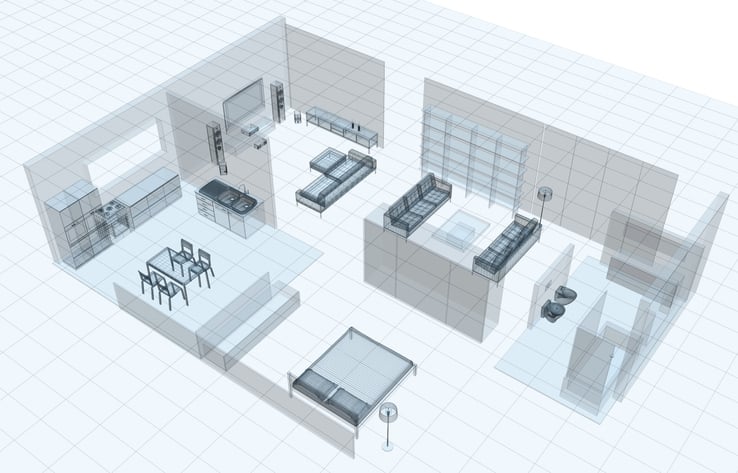Multi-Dwelling Unit | MDU | Wi-Fi | Managed Wi-Fi
How to Provide the Best Wi-Fi Coverage in a Multi-Dwelling Unit (MDU)

Bill Halvorsen, a U.S. Marine Corps Veteran, has worked in the telecommunications industry for 32 years. Starting his career as a radio repairman, electronics technician, and data network specialist in the Marines, Bill was hired by Cisco Systems to deliver services to service providers around the globe. After 21 years at Cisco, Halvorsen was hired by CCI Systems to specialize in Broadband Access Architectures as a Solution Architect.
“Add another access point!”
This is the typical answer when a technician is trying to get internet from one end of an apartment to the other.
With a solution approach, you should know where there are dead spots and where users aren’t getting the best coverage. By having this knowledge, you can add access points where the user will have the best experience.
But, what about the performance?
The performance of a network is dictated by a user’s ability to reach the access points.
If this isn’t happening, performance can suffer, and signal strength may become an issue, not only for the property but for the end user.
CCI Systems provides solutions that are the glue to enhancing a service provider’s network within MDUs. By leveraging multiple vendors with multiple technologies, CCI can provide superior Wi-Fi solutions for property owners and their tenants.
The main factors to consider when assessing a multi-dwelling unit are identifying where the Wi-Fi access points are placed within the MDU, diagnosing the signal strength of those access points, and enhancing signal quality by analyzing network data with analytic tools.

The Location of the Access Point
The first problem is the physical location of the access point within the multi-dwelling unit. The solution provider will not always have knowledge or control of where those access points are going to be located or placed.
The best-case scenario is the service provider captures an entire MDU. Then, they offer a base unit in each unit of the MDU as part of the initial internet package. Think of a base unit as an unappealing, rectangular box hidden out of sight.
By offering a base package with base units provided, tenants (i.e. end users) are not going to bring their modems and routers, which can create interference with other unmanaged access points.
Each base unit in each apartment can act autonomously with separate SSIDs, but it can also act communally. This can be an access point located within the modem itself or within the optical network unit (ONU) which acts as the gateway for the home.
Once the base units are installed and placed, all units are controlled within a central location. This allows Apartment A to be on one channel, and Apartment B to be accessed through another channel. Separating Apartment A and B with individual base units allows the service to boost performance on both channels.
The flip side is most service providers cannot proactively control where the base units will be placed, so they must work with what they have access to.
If a box is located at an access point in a hallway, wiring closet for a hotel, or in the utility room of an apartment with a washer and dryer, generally, none of these locations are the best location to enhance signal strength.
To frame this problem, imagine a tenant occupying an eight-hundred-to-twelve-hundred square foot apartment, and the wiring closet with the hot water heater is by the front door.
If the access point for the internet (i.e. the router or modem) is installed there, it might be too far away from the master bedroom. As a result, the internet may have problems getting a good signal to the back of the apartment.
Placing network access points in optimal locations the first time around can end up saving face for the MDU property owner and service provider. Plus, this maintains a healthy customer sentiment when it comes to their internet connection.
Enhancing Wi-Fi Signal Strength Within the Unit
Depending on where the access point is placed, the Wi-Fi signal strength will be affected.
The best way to combat a signal strength issue is by creating a wireless mesh. This is the easiest, most economical, and efficient solution.
Once the base station is in place (comprised of the base units), performance data is fed into a central database. In a managed Wi-Fi solution, this data is analyzed, and alerts can be sent when user experience drops below expected levels.
The service provider can then perform signal analysis.
While monitoring the inflow of analytics, a technician or engineer may see certain units where a laptop or iPhone appearing as the primary device is always in a weak signal area. This is where a wireless mesh can be implemented to enhance the Wi-Fi connection.
Most of these devices are aesthetically pleasing, provided by the service provider and the devices are typically little cylinders that can sit on a coffee table versus big, square boxes a tenant wants to hide in a closet.
These units are extended, meshed units, not repeaters, meaning the device can talk to the base unit and offer Wi-Fi in the weaker location.

Delivering a Solution for a Weak Signal
By having the apartment layouts available to the service provider, a technician can run signal analysis. Based on what they’re seeing, they can make recommendations on where to place an additional access point (or device) to create the wireless mesh.
After the analysis is run, the liaison into the MDU property owner (most times in the form of a service provider) explains: “We would like Unit 1301 and Unit 1305 to be given an extra unit to put in the master bedroom.”
After that, it’s as easy as a property manager dropping off a box to the tenant with an additional access point from the service provider. Better yet, they can leave a note saying: “We're trying to improve your Wi-Fi performance. Please place this router somewhere at the opposite end of your apartment, away from the current router.”
Once the tenant puts the access point somewhere away from the base unit, this gives further coverage for the entire apartment.
*Smaller apartments do not typically suffer from weak signals because the wiring or utility closet is in much closer proximity to the bedroom or living room.
Building Materials and How It Affects Signal Quality
While it’s not the first thing an MDU property owner thinks of, the building materials of their multi-dwelling unit property play a significant role in signal quality.
Depending on whether the apartment complex, hotel, or housing unit is built out of concrete or wood can be the difference in how and where to place MDU access points. Simply, the denser the material, the higher the probability the signal will be prevented from going through the walls of multiple units.
Traditionally, hotels are specifically designed to be layers-on-layers of concrete for fireproofing, whereas apartments are more often designed with wood.
Knowing the material helps the planning and layout of access points. Once the access points are installed, the analytics will tell you how well your layout works, and if you need to optimize it for the best user experience.
How does the service provider help to counteract this loss of signal?
In this instance, a service provider may utilize a wireless access point. It's an optical network unit (ONU) built-in or it can be a standalone access point.
From there, it’s plugged into the internet from a cable modem or passive optical network (PON) port. The device is placed in the apartment, but it's owned and being managed by the service provider.
Now, Wi-Fi 6 and every modern access point (i.e. Meraki, Nokia, Calix, Plume, Google, you name it) have built-in analytics.
The main type of analytics is a signal meter. The signal meter will know and identify other access points, or if there are other heavy-talkers, like 2.5 gigahertz, 5 gigahertz, LTE carriers, or a cordless phone. The analytics will always tell the service provider how each Wi-Fi device performs while it’s connected to the network.
Every access point can analyze any noise creation, or how good or bad it’s talking to the client. With a shotty connection issue, a technician working remotely can analyze the laptop in a master bedroom where the router sits by the front door, or they can see a neighboring unit is using a NetGear router that’s chatty on channels 6 and 7.
After an initial analysis and self-diagnostics check for the quality of the radio frequency (RF) in an apartment, the technician can avoid those channels automatically and enhance the quality of the signal or internet connection.
With a base station, performance can be analyzed in real-time, which allows the service provider to proactively add wireless units to an apartment to improve the signal quality and the overall service.
This solution only adds to the customer happiness and satisfaction of the tenant, who may be encouraged to re-sign their lease because of the outstanding Wi-Fi service.
In today’s day and age, a high-speed internet connection is a major consideration for any worker within the gig economy.
The Advantages of an End-to-End Solution from a Provider
Between the location of an access point and troubleshooting the signal strength, a solution provider with an end-to-end offering can anticipate and solve network connectivity issues from the onset. This saves time, money, and the reputation of the service provider and property owner.
This type of consultation would come in the form of bundled services offered by the service provider to the MDU property owner. This relieves the property owner from having to figure out what access point to put it in and how.

An end-to-end solution from a Wi-Fi access point connected to in-building access technology, like G.hn (i.e. the plumbing) that's connected to an optical line terminal (OLT) improves the overall quality of service being offered to the end user.
An outsourced solution provider can architect this whole solution from the OLT to the “plumbing” to the access point.
In the end, this boils down to using smart services like analytics to install and continue to offer solid internet service for MDU owners and their tenants.
Analytical tools allow technicians to operate remotely, find radio interference with ease, and automatically improve Wi-Fi performance from the base unit.
Sophisticated analytic functions and analyses, in the beginning, will improve the outcome.
Added Services Provide Greater Value to an MDU Owner
Finally, the other aspect most MDUs need is Wi-Fi coverage at the pool or in the parking lot surrounding those apartments. This type of assistance is something a solution provider can offer with differential services.
Community Access
One type of differential service offering is community access.
A connection at a pool, parking garage, or community space may require a community SSID. Depending on the solution (or need), a tenant’s SSID could follow them everywhere, or each space could have a communal SSID.
That’s an option.
Tiered Packages
Another differential service offering is tiered packages.
Let's say the base package is 20 megabits per second (MBPS) down, 5 MBPS up for the apartment. Every tenant will receive this standard package, but a tenant could buy 100 MBPS down, 35 MBPS up within a tiered package.
For example, Apartment A has a unique SSID that is rate-limited for the standard option of purchased bandwidth. However, Apartment B houses a gamer who does everything wireless and required a tiered package to satisfy internet gameplay without any lag.
On Wi-Fi 6 router, the unit can do up to 1 gigabyte per second (GBPS) down, 600 MBPS up. By purchasing the higher package, Apartment B can access the full breadth of bandwidth their device delivers.
On top of that, a solution provider can add capabilities, like cybersecurity, firewalling, and spam filtering. Those additional services can easily be added on a per-subscriber basis for the MDU.
This creates great value for both the service provider as well as the property owner.
Optimize the Access Points and Keep Your Tenants Happy
Let’s reiterate the point that a service provider who can capture an entire MDU will be much less likely for any of the problems herein to occur.
To go a step further, a service provider who works with an MDU property owner from the inception of the project will be in an even better position. On top of that, a service provider with access to a solution provider has an absolute recipe for success, a gourmet meal if you will.
By creating the best Wi-Fi signal quality and internet connection an MDU can offer their tenants, the tenant working remotely stays happy. And a happy tenant is profitable.
By working with a solution provider, like CCI, installing or having access to an access point with an analytic function will be a top priority. Our experts live in and out of highly complex to very simple MDU networks every day, so our consultative expertise comes from years of experience.
Learn how to approach an MDU property owner who may need to update the infrastructure of their network and/or their access points.

